Portugal
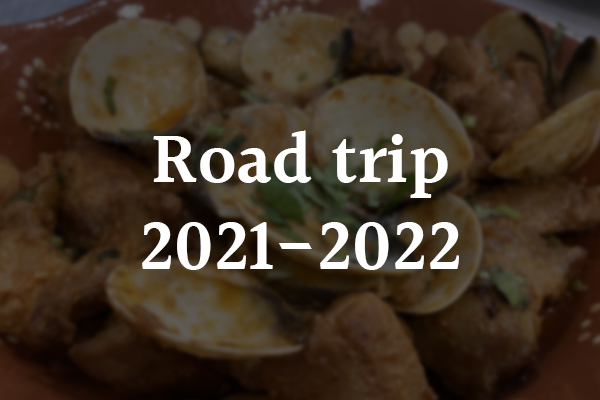
Portugal has been in my mind for quite a long time but I never managed to go. Then, Covid came, many plans were made and then fell apart. To celebrate 2022, the plan was to go to Jordan but, few weeks before the departure, all the borders were closed. And that is how Portugal happened! With the great company of Ilaria, we organized everything in two days and, despite all the adversities we faced, we managed to go, have a wonderful road trip and come back. Even though it was not so far from home and last minute, it was one of the best travel I have ever made!
Who could imagine that? All started with planning a nice trip to Jordan as coordinator of a group of
15
merry people and then, boom, Italy closed borders with Jordan on the 15th of December, not even two
weeks before the long-awaited departure. So, what to do? Spending another New Year's Eve locked
inside?
Absolutely not!
And that is how the adventure for Portugal started!
I had for some time the idea of a road trip in this country but, mostly for monetary reasons, I
postponed it. But when any other option seemed to be fading, I spoke to Ilaria, loyal companion
since
the trip to small Cyclades in summer 2022, and 3, 2, 1, our flights for Porto were booked.
I must say, everything seemed to be against it: Portugal government deciding you needed Covid tests
to
do check ins in hotels and, you know, this is an itinerary trip…, monuments closed to avoid
gatherings, Ilaria running not to miss the flight… but we made it, and that's all that counts.
Maybe especially because we had to organize everything super-fast, not only itinerary and
accommodations
but also Covid tests, insurance in case of quarantine and so on, the uncertain health situation
everywhere in Europe, I felt like this was wrong, that it was no good to leave risking to remain
blocked
somewhere far from home. Thankfully, I did not mention this to Ilaria because, as I later
discovered,
she had the same feelings, and we may have decided to give up and stay home. And then we would have
missed a travel that I now consider one of the bests I have ever done.
I like to add a brief introduction about the visited country when I write my travel journals so I
will
do it also this time.
Portugal is the second country, in terms of size, on the Iberian Peninsula. It is long and quite
thin
and faces on the Atlantic Ocean. This position was extremely favorable when the great sea
expeditions
started making a small European country a great power. Nowadays, that power is long gone but
Portugal
maintains a great charm and its history makes it a great country to visit. Being also not so big, it
is
easy to travel by car so that many on the road stops are possible. Nothing is missing, wine valley
that
became a UNESCO site, ocean with perfect waves for surfing, a tasty cuisine, a pilgrimage site that
attracts people from everywhere, and a charismatic personality.
Soundtrack: as I usually do, I must suggest at least one song to get in the travel mood. No Fado or
typical Lusitanian sounds but an Italian song that certainly describes the spirit of our travel:
La
vita
che seduce by Nomadi.
Day 1
 The first day is always the day of the -I am excited but also nervous-, especially at a time where
to travel you need so many extra documents, and masks, and apps, and sometimes also a miracle.
Before departing, we did the first Covid test of the fifth in total we have to do to complete the
travel. It seems a game and, thinking about it now, it almost was. Ilaria was already risking here
not to leave. At a dinner she was, almost everyone got Covid, on the way to the airport a bus broke
and a train almost left one second before she could catch it. We were lucky already! Nonetheless, we
departed and arrived in Porto, in the northern part of the country. Metro, hostel, we are in
Portugal, woo-hoo! There was no time to visit anything there, so we just walked to the city center
to see the river (Douro), the port cellars on the other side and smelling the smell of happiness.
We needed to celebrate! After all, everybody back in Italy was falling victim of the bloody virus
and forced into quarantine while we could have a nice dinner with octopus and port stew. Not bad,
eh?
The first day is always the day of the -I am excited but also nervous-, especially at a time where
to travel you need so many extra documents, and masks, and apps, and sometimes also a miracle.
Before departing, we did the first Covid test of the fifth in total we have to do to complete the
travel. It seems a game and, thinking about it now, it almost was. Ilaria was already risking here
not to leave. At a dinner she was, almost everyone got Covid, on the way to the airport a bus broke
and a train almost left one second before she could catch it. We were lucky already! Nonetheless, we
departed and arrived in Porto, in the northern part of the country. Metro, hostel, we are in
Portugal, woo-hoo! There was no time to visit anything there, so we just walked to the city center
to see the river (Douro), the port cellars on the other side and smelling the smell of happiness.
We needed to celebrate! After all, everybody back in Italy was falling victim of the bloody virus
and forced into quarantine while we could have a nice dinner with octopus and port stew. Not bad,
eh?
Day 2
Relaxed after our first night in Porto, we headed for breakfast with the pastel de nata, amazing egg
custard tart pastries decorated with sugar and cinnamon. D-E-L-I-C-I-O-U-S. Then, we went to the
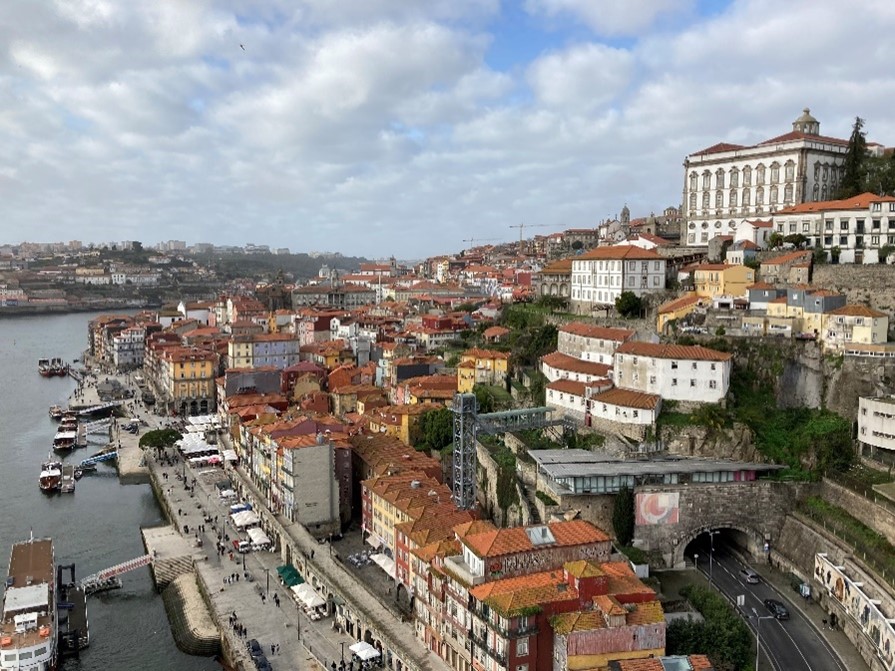 meeting point for the free walking tour we booked. Our guide was Speedy Gonzalez, and he was very
entertaining in explaining the story of the city. Until few years ago, Porto was way more degraded
than how it appears now but still you can see the medieval alleys sometimes cleaned and restored,
sometimes still dirty and run-down. But this is part of the city charm. The story of the city starts
back with the Romans as a little village and then evolving in the city from where, in the XII
century, Afonso Henriques started the Reconquista and then became first king of Portugal. There is
nothing to wonder then if the name Portugal also comes from Porto. This was the heart from which the
entire country developed. In 1387, an important marriage took place here: Dom João I and Filippa of
Lancaster. From the union, Henrique the Navigator was born, under who many explorations of new sea
routes started. This union also encouraged English wine merchants to start commercial trades. Many
of the companies found then are still existing today, producing port, one of the most famous wines
in the world.
meeting point for the free walking tour we booked. Our guide was Speedy Gonzalez, and he was very
entertaining in explaining the story of the city. Until few years ago, Porto was way more degraded
than how it appears now but still you can see the medieval alleys sometimes cleaned and restored,
sometimes still dirty and run-down. But this is part of the city charm. The story of the city starts
back with the Romans as a little village and then evolving in the city from where, in the XII
century, Afonso Henriques started the Reconquista and then became first king of Portugal. There is
nothing to wonder then if the name Portugal also comes from Porto. This was the heart from which the
entire country developed. In 1387, an important marriage took place here: Dom João I and Filippa of
Lancaster. From the union, Henrique the Navigator was born, under who many explorations of new sea
routes started. This union also encouraged English wine merchants to start commercial trades. Many
of the companies found then are still existing today, producing port, one of the most famous wines
in the world.
The tour was quite long, almost three hours. We went to the main city spots: the Station of São
Bento, one of the most beautiful train stations in the world, all decorated with azulejos, the Dom
Luis I bridge, based on the project of one of Eiffel's apprentices, and many others.
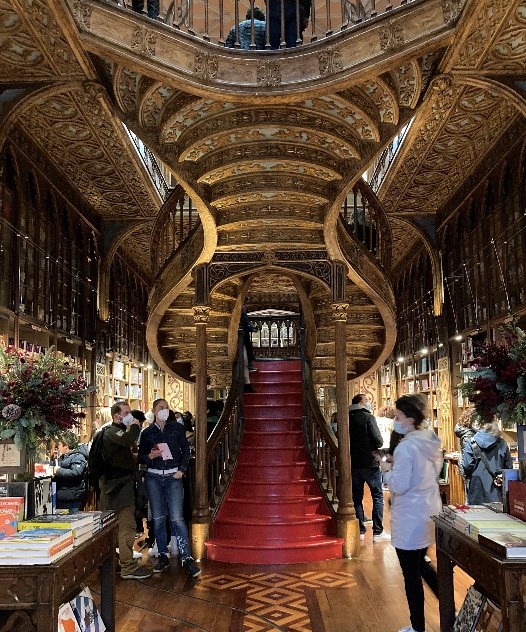 The azulejos, hand painted ceramic tiles, are one of the most typical art traditions in Portugal.
They cover many old houses and bring many advantages. First of all, being Portugal a maritime
country and suffering from humidity, tiles help to keep this outside. Also, in the summer, they help
in maintaining the inside of the houses fresher than the outside. Finally, they are just beautiful
and decorate in a unique way all the houses.
The azulejos, hand painted ceramic tiles, are one of the most typical art traditions in Portugal.
They cover many old houses and bring many advantages. First of all, being Portugal a maritime
country and suffering from humidity, tiles help to keep this outside. Also, in the summer, they help
in maintaining the inside of the houses fresher than the outside. Finally, they are just beautiful
and decorate in a unique way all the houses.
Food is important as well, so we had a good and restorative lunch in a local restaurant our guide
suggested us. Bacalao for me and pork for Ilaria and we are ready for a long queue outside Livraria
Lello. Legend says J. K. Rowling got inspired by the neogothic architecture of this peculiar
bookshop founder in 1906 for her Harry Potter books. The shop is worth a visit even if, nowadays, it
is more a touristic attraction than a bookshop. To have a look at it, check the picture two pages
before!
Even though we wanted to spend the rest of the afternoon wandering in the city, maybe doing some
port tastings, we had to go to the Covid lab. Our second test is coming. All good, it seemed, but
they lost my results and, while Ilaria could celebrate being negative, I wondered what to do on the
next day, as we were supposed to rent a car and spend the day outside of the city.
But it was late, the lab was closed, people started going out for dinner and we, too, left the
hostel looking for other good food to finish the day. The solution to this huge problem came from
just behind the corner. Another restaurant suggested by the guide was next to the hostel, so we felt
tired enough to do just minimum walk and eat there.
Day 3
The alarm this morning did not have pity of us. To take the most advantage of the day, we booked the
car quite early. Surprise surprise, they gave us a convertible Fiat 500 that we would have called
Ginja, a lovely name of a lovelier cherry liqueur produced in the country. The day was not the best
 to try the potential of our convertible baby as it was raining, and the air must have been at least
200% humid but we were excited to finally be in the car and start our proper road trip! First,
though, we stopped at the lab to investigate on my Covid results, that with some delay, reappeared
making me breathe again and giving us the green light to drive outside Porto, direction Braga.
to try the potential of our convertible baby as it was raining, and the air must have been at least
200% humid but we were excited to finally be in the car and start our proper road trip! First,
though, we stopped at the lab to investigate on my Covid results, that with some delay, reappeared
making me breathe again and giving us the green light to drive outside Porto, direction Braga.
Ok, expectations for Braga were quite high. It is the third city of Portugal, and the guide
describes it as an elegant maze of alleys, but we did not find it very attractive. Probably, the bad
weather did not help but, after a short stop at the cathedral -the oldest in Portugal, from 1070- we
left the city. We saw that close by there is a famous sanctuary, the Sanctuary of Bom Jesus do
Monte, so we gave it a go. It could have not been less interesting than Braga, after all. And we
were not wrong! It was actually a very interesting place. It is formed by various chapels and
allegoric representations of the five senses. A bit less interesting were the 520 steps we had to
make to reach the top, but the view compensated the effort.
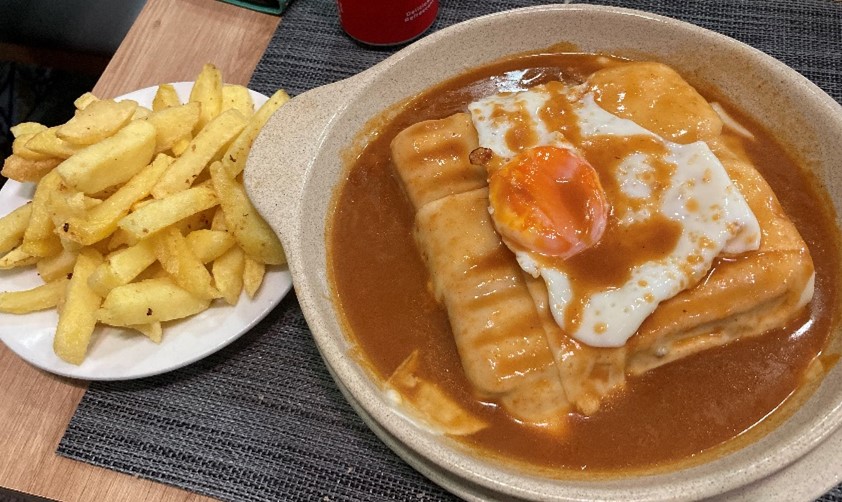 Slowly, also the weather started to improve, and we were glad for that as our next stop was Pinhao,
in the Douro Valley. The way to arrive there was wonderful: vineyards terraces everywhere and wine
cellars every now and then. It is not a surprise that this place became a UNESCO site. The city
itself was no special but we found the Quinta do Bomfim, one of the most famous cellars.
Apparently, to visit it, we were supposed to book in advance, but truth is that, due to the many
Covid restrictions, tourists were very few, so we just joined the next group. It was an interesting
visit as they explained us how port wine is produced, how it works with the grapes and the ground
and how the wine is stored before it is possible to drink it. All very interesting but not as much
as the final tasting. The visit was quite expensive, but it was worth the price as you get three
full glasses of the wine you pick. We got two different selections to try six different ones.
Obviously, in no time we were tipsy and not so ready to drive back to Porto to finish the day.
Thankfully, Ilaria did not appreciate the port as I did and was sober enough to take us back safe
and sound!
Slowly, also the weather started to improve, and we were glad for that as our next stop was Pinhao,
in the Douro Valley. The way to arrive there was wonderful: vineyards terraces everywhere and wine
cellars every now and then. It is not a surprise that this place became a UNESCO site. The city
itself was no special but we found the Quinta do Bomfim, one of the most famous cellars.
Apparently, to visit it, we were supposed to book in advance, but truth is that, due to the many
Covid restrictions, tourists were very few, so we just joined the next group. It was an interesting
visit as they explained us how port wine is produced, how it works with the grapes and the ground
and how the wine is stored before it is possible to drink it. All very interesting but not as much
as the final tasting. The visit was quite expensive, but it was worth the price as you get three
full glasses of the wine you pick. We got two different selections to try six different ones.
Obviously, in no time we were tipsy and not so ready to drive back to Porto to finish the day.
Thankfully, Ilaria did not appreciate the port as I did and was sober enough to take us back safe
and sound!
Again, following the guide's suggestion of the previous day, we tried a typical Porto dish called
Francesinha. As a visitor, I felt like I had to try it, but I can assure this is the recipe for
obesity and heart problems. It presents itself as a sandwich containing sausage, ham, a beef steak,
covered with melted cheese and a tomato sauce. As the dish is still quite poor, it comes with a
fried egg on top and side of fries. Perfect when you are on a strict diet!
Day 4
Probably my digestion of the previous meal -see above- was not completely finished, when we woke up
the next day and we had breakfast with crunchy and soft pastel de nata.
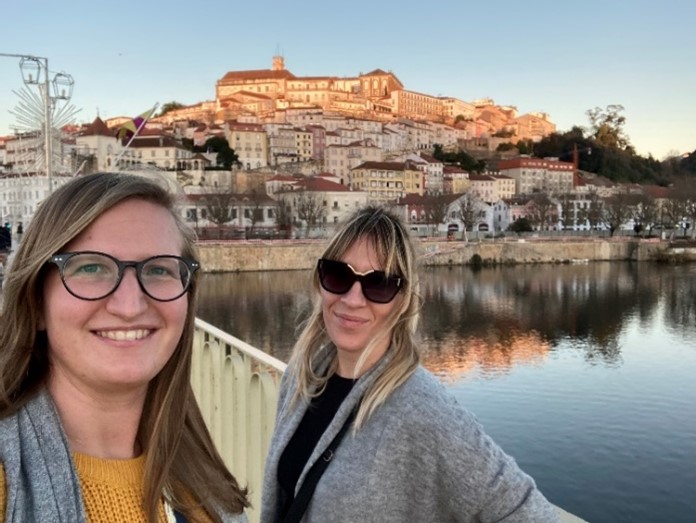 *DISCLAIMER: don't go to Portugal if you intend to eat light*
It was needed, though, because we had to drive quite a lot to reach our next destination: Coimbra.
Nowadays, this city is mostly famous for its university, as well inscribed in the UNESCO heritage,
but, in the past, it was also capital of Portugal.
It was funded by the Romans and then governed by the Moors, who left traces in the city plan, until
it was conquered by the Christians in 1064. The university is the oldest in the country and
attracted students and intellectuals for centuries. It is needless to say that we could not
experiment any of the academic life, at least the one outside of the classes, as all the students
were on holiday and most of the buildings were closed. Part of them is anyway only a museum and we
went to visit them. The core is the Joanina Library, in baroque style and decorated with frescoes,
it contains about 40 thousand books. The guide says that there is also a bat colony to keep insects
away. We did not see any but probably they were resting somewhere in the dark to compensate their
hard work.
*DISCLAIMER: don't go to Portugal if you intend to eat light*
It was needed, though, because we had to drive quite a lot to reach our next destination: Coimbra.
Nowadays, this city is mostly famous for its university, as well inscribed in the UNESCO heritage,
but, in the past, it was also capital of Portugal.
It was funded by the Romans and then governed by the Moors, who left traces in the city plan, until
it was conquered by the Christians in 1064. The university is the oldest in the country and
attracted students and intellectuals for centuries. It is needless to say that we could not
experiment any of the academic life, at least the one outside of the classes, as all the students
were on holiday and most of the buildings were closed. Part of them is anyway only a museum and we
went to visit them. The core is the Joanina Library, in baroque style and decorated with frescoes,
it contains about 40 thousand books. The guide says that there is also a bat colony to keep insects
away. We did not see any but probably they were resting somewhere in the dark to compensate their
hard work.
After the library, we wandered a bit in the old town, visiting the old and new Cathedrals and
enjoying the Portuguese sun. It is incredible to think we were walking without jackets at the end of
December, but the weather was really fantastic! Because of this nice weather, we also took a small
detour inside the botanical garden.
After lunch, we continued the visit of the other university buildings and then we headed to a new
Covid lab because, guess what, we had to do another Covid test! Once done, hoping for good news, we
had just one last walk, this time in the new part of the city, what is called Baixa, and then we
decided to treat ourselves with a sushi delivery in the hotel.
Day 5
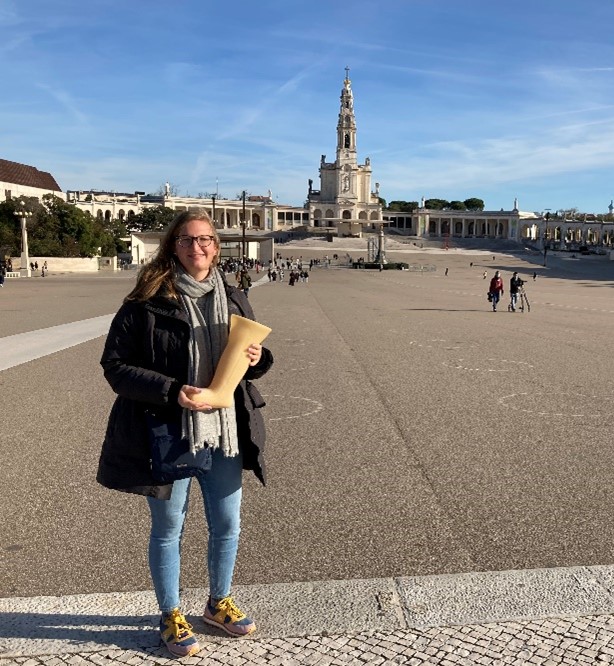 Unfortunately, the plans for today were completely disrupted when we discovered they decided to
close all major monuments on the festive and pre-festive days to avoid gatherings. The idea was to
go to Batalha, so we had to quickly think of an alternative. We did actually pass by Batalha, at
least to see it from outside but then moved on to Fátima, the famous pilgrimage town. According to
the tradition, here, on the 13th of May 1917, the Virgin Mary appeared to three shepherd children:
Lúcia, Francisco, and Jacinta. Since then, the place became a pilgrimage destination and, where
before there was nothing, now there are two big churches and a huge esplanade in between. Every
sanctuary has its own tradition and here, it is to burn candles and wax small (or big) reproductions
of body parts, figures and so on. Given my continues feet and leg problems, I got a wax left leg and
I threw it in the fire. Apparently, I did something wrong because my issues on the left side got
worse instead of better, but that is another story. On certain times, the esplanade is so full of
people that, to cross it and burn candles and votive offers, you may need to queue for hours. We
only waited few minutes, thankfully! More or less at the center of the esplanade, there is the
Apparition Chapel, where the Virgin appeared for five times. We stopped there a moment and then
visited one of the two churches, the one where the three children are buried.
Unfortunately, the plans for today were completely disrupted when we discovered they decided to
close all major monuments on the festive and pre-festive days to avoid gatherings. The idea was to
go to Batalha, so we had to quickly think of an alternative. We did actually pass by Batalha, at
least to see it from outside but then moved on to Fátima, the famous pilgrimage town. According to
the tradition, here, on the 13th of May 1917, the Virgin Mary appeared to three shepherd children:
Lúcia, Francisco, and Jacinta. Since then, the place became a pilgrimage destination and, where
before there was nothing, now there are two big churches and a huge esplanade in between. Every
sanctuary has its own tradition and here, it is to burn candles and wax small (or big) reproductions
of body parts, figures and so on. Given my continues feet and leg problems, I got a wax left leg and
I threw it in the fire. Apparently, I did something wrong because my issues on the left side got
worse instead of better, but that is another story. On certain times, the esplanade is so full of
people that, to cross it and burn candles and votive offers, you may need to queue for hours. We
only waited few minutes, thankfully! More or less at the center of the esplanade, there is the
Apparition Chapel, where the Virgin appeared for five times. We stopped there a moment and then
visited one of the two churches, the one where the three children are buried.
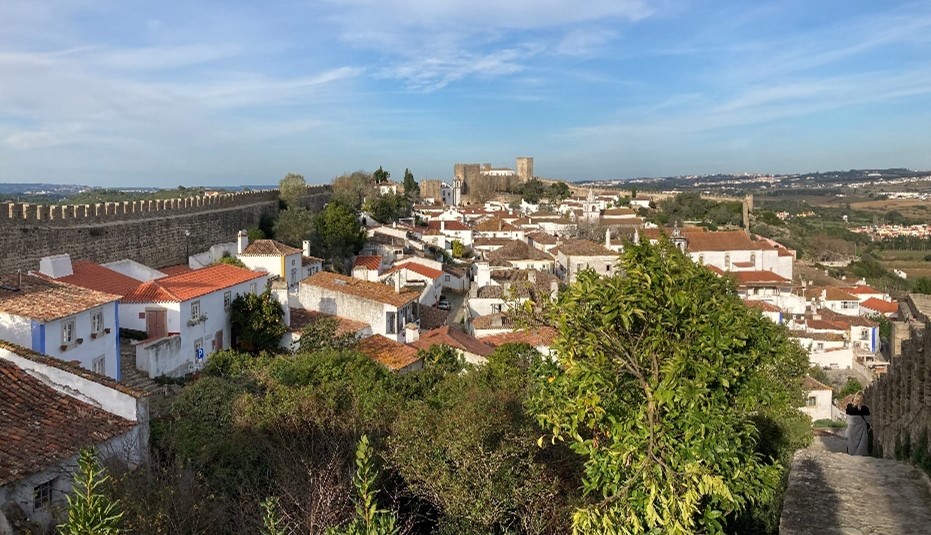 After this religious stop, we drove to Óbidos, a medieval town that remained intact with its walls
and white houses. Even though it became a bit touristy, there is still a good atmosphere. Among all
the people that consider the city a jewel, there was also the wife of king Dom Dinis so that he
decided to gift it to her. Not bad as a present! The city plan was made also here by the Moors, who
abandoned the city short before 1228, when Dom Dinis came to visit. Beside wandering in the small
alleys, it is still possible to walk along the entire city walls, a path of 1560 m. Here, it is also
the place where we tried for the first time the liqueur ginja. Called also ginjinha, it is made by
putting sour cherries in alcohol and adding sugar and some other secret ingredient. It is typical of
some Portuguese cities like Óbidos and Lisbon. Here, it is served in dark chocolate cups you can eat
after the shot. It is not too strong, and it is quite sweet so perfect to enjoy while relaxing. We
liked it so many that our car was officially named after it!
After this religious stop, we drove to Óbidos, a medieval town that remained intact with its walls
and white houses. Even though it became a bit touristy, there is still a good atmosphere. Among all
the people that consider the city a jewel, there was also the wife of king Dom Dinis so that he
decided to gift it to her. Not bad as a present! The city plan was made also here by the Moors, who
abandoned the city short before 1228, when Dom Dinis came to visit. Beside wandering in the small
alleys, it is still possible to walk along the entire city walls, a path of 1560 m. Here, it is also
the place where we tried for the first time the liqueur ginja. Called also ginjinha, it is made by
putting sour cherries in alcohol and adding sugar and some other secret ingredient. It is typical of
some Portuguese cities like Óbidos and Lisbon. Here, it is served in dark chocolate cups you can eat
after the shot. It is not too strong, and it is quite sweet so perfect to enjoy while relaxing. We
liked it so many that our car was officially named after it!
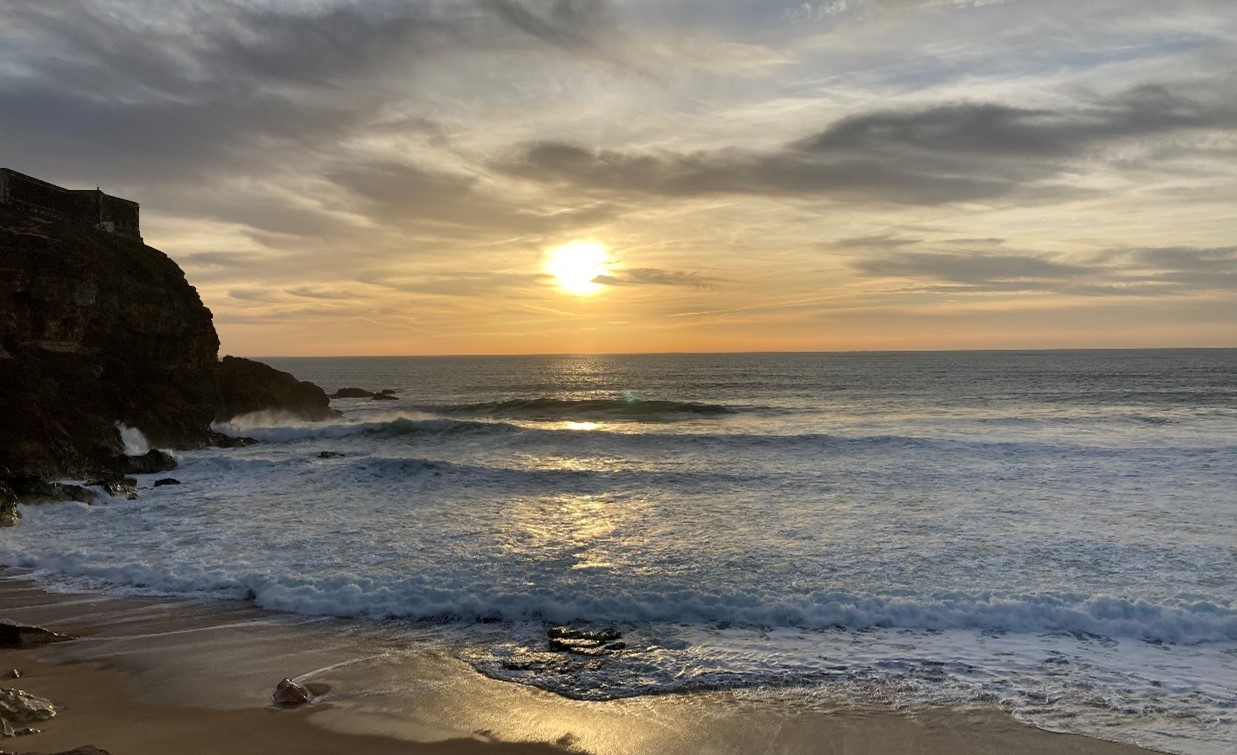 We then still had some light hours and some kilometers to make it back to Coimbra, so we stopped a
bit in Nazaré. This small town, famous mostly for the high waves and the surfers that come from
wherever just for them, was for sure a surprise. One of the records of the highest surfed wave was
done by Garrett McNamara who reached 23.77 m in 2011. Basically, an eight-floors building.
We did not see any high wave but a beautiful sunset, the last one of 2021.
We then still had some light hours and some kilometers to make it back to Coimbra, so we stopped a
bit in Nazaré. This small town, famous mostly for the high waves and the surfers that come from
wherever just for them, was for sure a surprise. One of the records of the highest surfed wave was
done by Garrett McNamara who reached 23.77 m in 2011. Basically, an eight-floors building.
We did not see any high wave but a beautiful sunset, the last one of 2021.
Once back in Coimbra, we celebrated our own way. We decided not to go out as stricter restrictions
were in place and there was nothing major going on anyway. So, we ordered sushi again and open a
bottle of wine. At midnight, when we (almost) fell asleep, Coimbra surprised us with very nice
fireworks just in front of our window. A nice last sparkle of the past year and, hopefully, good
wishes for the new one.
Day 6
And here we are, kicking off a new year with again amazing weather and amazing places. The plan to
visit the Convento do Cristo in Tomar fell apart as well as it was closed. Everything was closed
around us, and we even thought about doing a quick day trip to Spain, until we found out everything
was closed there, too.
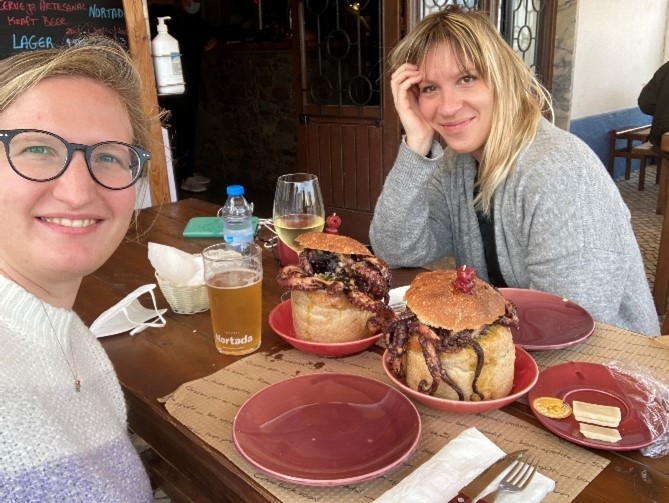 We then decided to go to Peniche, another nice town on the coast the promised to offer good views
and, potentially, good food options.
The view from there was indeed superb and we took the chance to do a photoshoot to our beloved Ginja
as well.
We then decided to go to Peniche, another nice town on the coast the promised to offer good views
and, potentially, good food options.
The view from there was indeed superb and we took the chance to do a photoshoot to our beloved Ginja
as well.
Peniche is an active port, and, in the past, there was a fortress, now open to the public, where the
political prisoners were held during Salazar's dictatorship.
After the photo shootings, we went to look for food and we found our place in no time. The tavern
itself was quite small and had just a couple of tables outside but the sign with the name, Ginja,
was well visible from afar. And how could we resist the call of Ginja? We were served an entire
octopus each, served in bread and cooked with the sweet liqueur: a well-deserved new year's lunch.
It took all our effort to devour the poor octopuses (see below for our shocked faces) and happy and
well fed, we finally left the coast to the next city stay.
It took us some hours driving to make it to Évora, a medieval city well preserved and still
surrounded by its original XIV century walls.
As Coimbra, also Évora has an important university that, at the time of our visit, was closed
leaving the city with an atmosphere of ghost town. We explored it a bit in the evening and managed
to see the Roman Temple and the small alleys in white and the yellows, the colors given to all the
houses.
We had a quick dinner more out of habit than for real hunger and we were quite unlucky to get
probably the worst of the whole trip. A pity, as the cuisine of this Portuguese region is known for
its delicacies.
Day 7
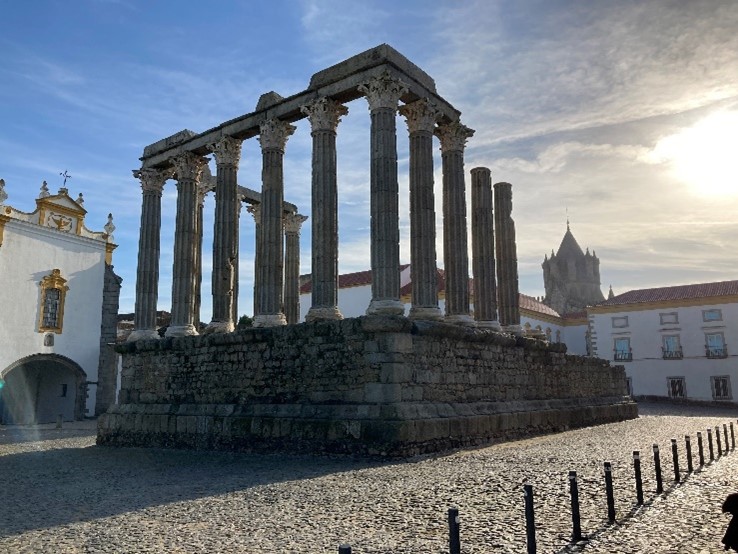 The next day in Évora, the city already looked better. With a good sleep, the shining sun, a good
breakfast with our usual pastel de nata and orange juice, everything would have looked brighter. We
went back to see the Roman Temple and again, we were stunned by seeing 14 perfectly preserved
columns standing in the middle of a Middle Age square from the II-III century. They represent the
best-preserved Roman remains of the entire peninsula and were part of a Roman Forum. What is still
unsure is to who the temple was dedicated. Something that, to be honest, does not prevent of
admiring the extraordinary abilities of the Romans architects.
The next day in Évora, the city already looked better. With a good sleep, the shining sun, a good
breakfast with our usual pastel de nata and orange juice, everything would have looked brighter. We
went back to see the Roman Temple and again, we were stunned by seeing 14 perfectly preserved
columns standing in the middle of a Middle Age square from the II-III century. They represent the
best-preserved Roman remains of the entire peninsula and were part of a Roman Forum. What is still
unsure is to who the temple was dedicated. Something that, to be honest, does not prevent of
admiring the extraordinary abilities of the Romans architects.
Right next to the temple, the city cathedral rises. We visited it inside, walked in cloister and
climbed up to the roof, from where we got a beautiful view. Where the cathedral was started to be
built in 1168, there was originally a mosque. Here, also, the flags later put on Vasco da Gama's
ships were blessed.
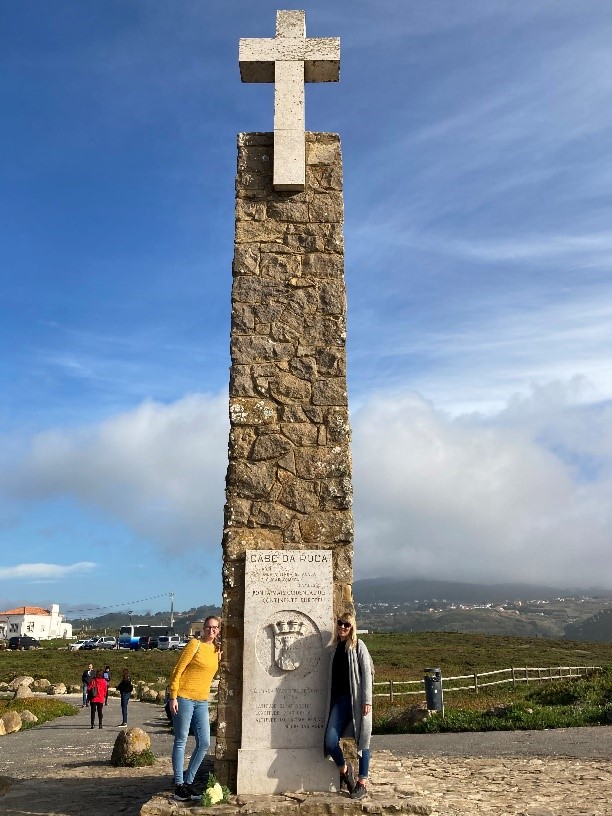 Our last stop in Évora was then the Igreja de Sao Francisco and the incredible, and a bit creepy,
Capela dos Ossos. This one is a chapel completely decorated with bones as memento mori. Estimations
say that the bones belong to about five thousand people and its construction was the solutions some
monks had to fight the cemeteries overcrowding. While the accomplishments were enough or not, the
outcome is a monument many people still visit today.
Our last stop in Évora was then the Igreja de Sao Francisco and the incredible, and a bit creepy,
Capela dos Ossos. This one is a chapel completely decorated with bones as memento mori. Estimations
say that the bones belong to about five thousand people and its construction was the solutions some
monks had to fight the cemeteries overcrowding. While the accomplishments were enough or not, the
outcome is a monument many people still visit today.
Our very last stop in Évora was actually the second last Covid test. Once we got our noses swabbed,
we left the city directed to one of the most fascinating places of our travel.
It took us not long to drive back towards the sea, pass Lisbon and arrive in Cabo da Roca, the
westernmost point of mainland Europe. Usually, the way there is full of cars and tourists that take
the winding way to take a picture on the top of this cape but the whole situation, that did not help
us in finding Batalha and Tomar open, helped us in enjoying a quiet and still a bit wild time here.
On the way back to Lisbon, our last stay, we stopped in Sintra. This is a small town where people
from Lisbon take day trips to. It is surrounded by woods and hides castles and palaces around.
Going back another time, it would probably better to plan an entire day there and organize it
better. Our time, however, was limited and we had to make the best out of it. The best included
driving where probably we were not supposed to and attempt a park that looked like a failure since
the beginning. Detours aside, for which, at least, we were not fined, we managed to reach the square
where the Palácio Nacional de Sintra stands. This is the iconic building of the town. It is made of
various rooms, decorated with azulejos, Moorish items representing the union of the Moorish and
Manueline styles. I would have wanted to go to the top of the hill and visit the Castelo dos Mouros,
but we then learned that required a long hike, so we had to give up.
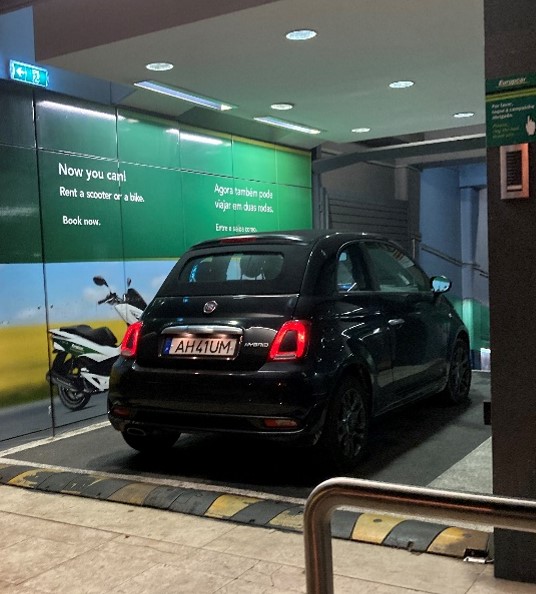 We only had time for a quick stop, in the end, but we definitely had time to stop by what is known
to be the original factory of queijadas, small tarts filled with cheese, sugar, and cinnamon. This
place is producing them since 1756 and the queue outside is an obvious proof of the quality of this
dessert. But could we trust it? Of course not. A taste was necessary to confirm the rumors. Beside
this delicacy, another dessert is famous in Sintra: the travesseiro. Literally, it means pillow, and
it is a tart filled with a cream made of yolks and almonds. Truth is, it was hard to decide what we
preferred and, in the end, could not decide.
We only had time for a quick stop, in the end, but we definitely had time to stop by what is known
to be the original factory of queijadas, small tarts filled with cheese, sugar, and cinnamon. This
place is producing them since 1756 and the queue outside is an obvious proof of the quality of this
dessert. But could we trust it? Of course not. A taste was necessary to confirm the rumors. Beside
this delicacy, another dessert is famous in Sintra: the travesseiro. Literally, it means pillow, and
it is a tart filled with a cream made of yolks and almonds. Truth is, it was hard to decide what we
preferred and, in the end, could not decide.
Finally, when the day was almost done and the sky already dark, we drove our last kilometers to
Lisbon.
There, we said goodbye to Ginja, our loyal companion for 1624 km around Portugal. And we went for
dinner to compensate the sudden sadness. Guess what? Sushiiiiii!
Day 8
The first morning without Ginja was still sad but we got to try the Lisbon transportation system. To
start, we took a combination of buses and trams to go to the Tower of Belém. Of course, we forgot to
check the opening times of the close Mosteiro dos Jerónimos, so we had the bad surprise of finding
it closed.
To alleviate the sadness, we went to the nearby Pastéis de Belém, a bakery where we had the most
amazing pastéis de nata of the whole trip. Breakfast done; we walked a bit to find the terminal of
tram number 28. It is quite popular because it is a historic one and, more than that, it runs
through the city allowing whoever takes it to see the most important sights of Lisbon. It was
perfect because we had to go back to the city center, and we managed to rest a bit.
In the afternoon, we met our guide for the free walking tour of Lisbon. His name was Antonio, and he
was very nice and entertaining. We learned a bit more about the story of the city.
Lisbon is the second oldest capital city in Europe and has seen it all. The founders and first
inhabitants were the Phoenicians, around 3000 years ago, and later, many other populations arrived.
In 714, the Moors conquered and kept it until 1147, when Dom Afonso Henriques got it for the
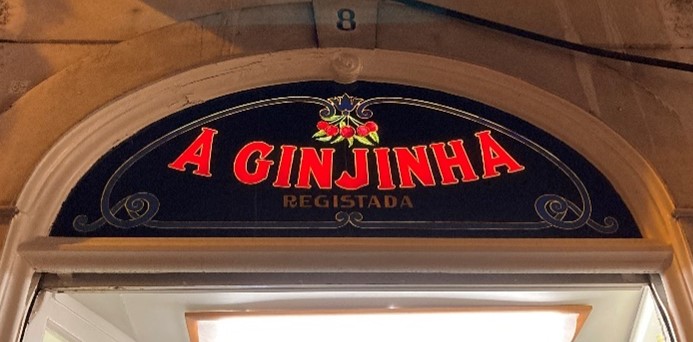 Christians. In 1255, it became the capital of the kingdom, previously in Coimbra. With the overseas
explorations, Lisbon became richer and richer until, on the 1st of November 1755, a terrible
earthquake, followed by many fires and a tsunami, destroyed completely the city. In 1908, the
monarchy ended when the king and his son were murdered. After that, many disorders happened and
Portugal saw the longest dictatorship in the European history, which ended in 1974. Nowadays, Lisbon
is still an attractive city, with more and more tourists every year.
Christians. In 1255, it became the capital of the kingdom, previously in Coimbra. With the overseas
explorations, Lisbon became richer and richer until, on the 1st of November 1755, a terrible
earthquake, followed by many fires and a tsunami, destroyed completely the city. In 1908, the
monarchy ended when the king and his son were murdered. After that, many disorders happened and
Portugal saw the longest dictatorship in the European history, which ended in 1974. Nowadays, Lisbon
is still an attractive city, with more and more tourists every year.
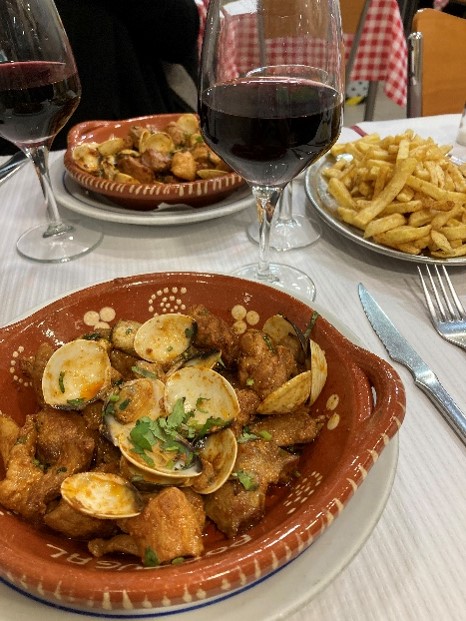 After the visit finished, we decided to go to Alfama, the oldest part of the city because not
destroyed by the earthquake. Here, the streets remind of the Moorish past and every corner hides a
surprise. We went to the Cathedral, to light the last candle to the Mary of Fátima before the last
Covid test, and then hiked up to the Miradouro da Senhora do Monte, from where we had a beautiful
view over the city.
Before heading to the dinner place Antonio suggested us, we had to stop in a very special place, A
Ginjinha. As the name suggests, in this small place, there is only one drink sold, the one and only
ginja. This was the perfect aperitif to prepare us for one of the most typical Portuguese dishes:
the Alentejana pork. It is a combination of pork and clams, cooked together with spices and
potatoes. The mix can sound a bit odd, but the taste was good. We were in this very typical
restaurant, A gruta de Camoes, that made the experience even better.
After the visit finished, we decided to go to Alfama, the oldest part of the city because not
destroyed by the earthquake. Here, the streets remind of the Moorish past and every corner hides a
surprise. We went to the Cathedral, to light the last candle to the Mary of Fátima before the last
Covid test, and then hiked up to the Miradouro da Senhora do Monte, from where we had a beautiful
view over the city.
Before heading to the dinner place Antonio suggested us, we had to stop in a very special place, A
Ginjinha. As the name suggests, in this small place, there is only one drink sold, the one and only
ginja. This was the perfect aperitif to prepare us for one of the most typical Portuguese dishes:
the Alentejana pork. It is a combination of pork and clams, cooked together with spices and
potatoes. The mix can sound a bit odd, but the taste was good. We were in this very typical
restaurant, A gruta de Camoes, that made the experience even better.
Day 9
For once, we had a very late wake up, as the Covid test was close to the hotel and booked around 11.
Sadly, this was also the last day in Lisbon, but we had a splendid weather, so we were lucky. It was
by no meaning the most painful Covid test we took, the lady was extremely rude. However, this was
done, and we just had to wait for the final result to know if we could fly back or not.
To help easing the stress, we went again to Pastéis de Belém for a good breakfast and, while there,
we got the news that we were negative, so free to go back to Italy in the evening. To celebrate, we
treated us with an extra pastel de nata.
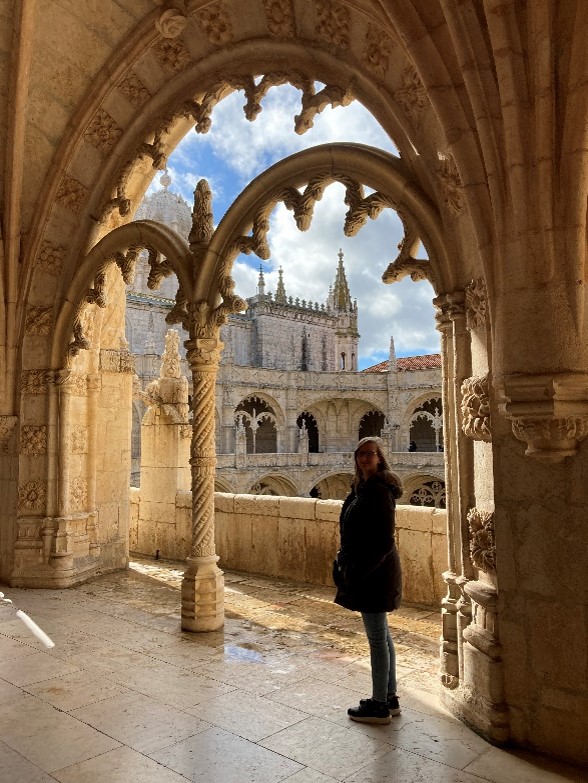 We definitely wanted to visit the Mosteiro dos Jerónimos we missed the day before and it was totally
worth it. This huge complex is the perfect example of the Manueline style. So far, I haven't
mentioned exactly what this is so let me explain. It is a Portuguese architectural style originating
in the 16th century, during the Portuguese Renaissance and Age of Discoveries. Manueline
architecture incorporates maritime elements and representations of the discoveries. This innovative
style synthesizes aspects of the Gothic architecture with original motifs and influences of the
Plateresque, Mudéjar, Italian, and Flemish architecture.
The construction of this specific monastery was possible thanks to the income coming from the spices
trade and provided by Manuel I. It was commissioned by the king to celebrate the discovery of the
route to India. Vasco da Gama, the man who discovered the route, is also buried here.
Inside, the church is astonishing but even more the cloister, which is richly decorated in a stone
that is modeled like plaster.
We definitely wanted to visit the Mosteiro dos Jerónimos we missed the day before and it was totally
worth it. This huge complex is the perfect example of the Manueline style. So far, I haven't
mentioned exactly what this is so let me explain. It is a Portuguese architectural style originating
in the 16th century, during the Portuguese Renaissance and Age of Discoveries. Manueline
architecture incorporates maritime elements and representations of the discoveries. This innovative
style synthesizes aspects of the Gothic architecture with original motifs and influences of the
Plateresque, Mudéjar, Italian, and Flemish architecture.
The construction of this specific monastery was possible thanks to the income coming from the spices
trade and provided by Manuel I. It was commissioned by the king to celebrate the discovery of the
route to India. Vasco da Gama, the man who discovered the route, is also buried here.
Inside, the church is astonishing but even more the cloister, which is richly decorated in a stone
that is modeled like plaster.
Since the weather was good and we had time, we also went back to the Tower of Belém, close by. this
is a fortress and served as a point of embarkation and disembarkation for Portuguese explorers and
as a ceremonial gateway to Lisbon.
Finally, we indulged in one last lunch before heading back to the hotel, getting the luggage, and
then saying see you soon to this wonderful country.